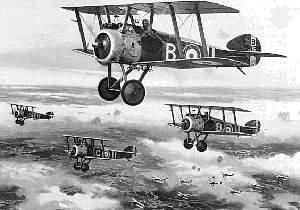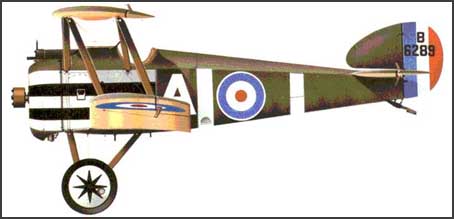

The First World War saw the advent of the airplane as a viable military weapon. In a period of only a few years, military aircraft advanced from rudimentary flying craft to killing machines. During this time, aerial superiority over the front changed hands as often as new designs were introduced. In 1916, the Germans controlled the skies over the trenches, and the English developed three fighters to regain control of the air war. The best and most famous of these three designs was the Sopwith Camel. Small and lightweight, the Camel represented the state-of the-art in fighter design at the time. The Sopwith Camel shot down 1,294 enemy aircraft during World War I, more than any other Allied fighter. However, it was so difficult to fly that more men lost their lives while learning to fly it than using it in combat.
The Sopwith company rolled out the first Camel in December 1916. Although it owed much of its design to earlier Sopwith aircraft like the Tabloid, Pup and Triplane, the Camel was a revolutionary machine in a number of respects. The plane's Twin Vickers machine guns were mounted side by side in front of the cockpit -- a first for British fighters and a design feature that became standard on British fighters for nearly 20 years. Second, the pilot, engine, armament and controls were all crammed into a seven foot space at the front of the airplane. This helped give the plane its phenomenal performance, but it also made the plane very tricky to fly. Additionally, the plane's wood and fabric construction and lack of protection for the fuel tank made the Camel (like most WWI aircraft) very susceptible to fire. Moreover, the poor state of pilot training during 1916-1917 meant that the average life expectancy of an English pilot was little more than two weeks.
Camel Cockpit With Front Mounted Twin Vickers
In service, the Camel proved to be a huge success, despite its high accident rate. Camels fought all along the Western Front as well as being employed as night fighters and balloon busters. Some the earliest fighters used by the Royal Navy were Camels which were deployed from cruisers, battleships and even towed platforms. Additionally, Camels fitted with eight Le Prieur air-to-air rockets proved to be very effective against German Zeppelins and long-range bombers.
THE ZEPPELIN KILLER:
Sopwith Camel fitted with eight Le Prieur air-to-air rocketsZEPPELIN
In 1944 British playwright and author W. Somerset Maugham's novel "The Razor's Edge" was published. The story takes place just after World War I and follows a young American Maugham calls Larry Darrell as he searches for spiritual awakening. High in the mountains of India he experiences Enlightenment. However, what drove him on his quest initially was seeing his best friend die in front of his eyes following a dogfight with the Germans. Darrell had gone to Canada, enlisted in the Canadian military at age sixteen and was flying through them for the British in France by 1917. His best friend was an Irishman called Patsy. Patsy taught him everything he needed to know and how to survive. Inturn, in the end, it was Patsy that Larry saw die...after saving his life. Although the type plane both Larry and Patsy flew is never mentioned in the novel, it is known they were Sopwith Camels (source). Maugham had seen the war and the war's carnage at field level because, like Ernest Hemingway and other writers and authors of the time, he was a former volunteer ambulance driver, one of the so-called Literary Ambulance Drivers. The following is Maugham's discription of what happened as he listens to Larry tell the story:
"The day we were to go on leave (to Paris) we were sent up to fly over the enemy lines and bring back reports of what we saw. Suddenly we came bang up against some German planes, and before we knew where we were we were in the middle of a dogfight. One of them came after me, but I got in first. I took a look to see if he was going to crash and then out of the corner of my eye I saw another plane on my tail. I dived to get away from him, but he was on to me like a flash and I thought I was done for; then I saw Patsy come down on him like a streak of lightning and give him all he'd got. They'd had enough and sheered off and we made for home. My machine had got pretty well knocked about and I only just made it. Patsy got in before me. When I got out of my plane they'd just got him out of his. He was lying on the ground and they were waiting for the ambulance to come up. When he saw me he grinned."
"I got the blighter who was on your tail," he said.
"What's the matter, Patsy?" I asked.
"Oh, it's nothing. He winged me."
"He was looking deathly white. Suddenly a strange look came over his face. It had just come to him that he was dying, and the possibility of death had never so much as crossed his mind. Before they could stop him he sat up and gave a laugh."
"Well I'm jiggered," he said.
"He fell back dead. He was twenty-two. He was going to marry a girl in Ireland after the war.
According to Maugham, up to that time, seeing his best friend die right in front of his eyes was the most important turning point in Darrell's young life. Without question, a major turning point, but it wasn't exactly the only turning point. It was more like the straw that broke the camel's back. Maugham writes that Darrell was wounded twice. He dosen't make issue with either, simply citing them, then moving on. However, as left out of the narrative by Maugham either because he didn't know it or he didn't want to get into it, one of those two wounds was so serious that following hospitalization he was required to take two weeks mandatory leave in order to recuperate. It was what happened during those two weeks that an issue should have been raised but wasn't, a never reported issue that involved what is known as Our Lady of Fatima. Actually, Darrell returned from his R&R experience in Fatima filled with enthusiasm, overwhelmed with a positive feeling for the future. He hadn't lost the lust to fly, he just couldn't engage the enemy like he did before. His friend said he lost his edge, letting unflinching adversaries get through. On practically the last day of the war and almost the last hour that's what happened. Darrell's friend doubled back to cover him from German fighters coming up on his tail and lost his life doing so. When my mentor saw his best friend die right in front of his eyes on the tarmac he said being hit in the face by a sledge hammer couldn't have hurt worse. In response to it all, early in the book, following the end of the war and his return home Darrell, in conversation with his fiancee' Isabel, says:
"I don't think I shall ever find peace till I make up my mind about things," he said gravely. He hesitated. "It's very difficult to put into words. The moment you try you feel embarrassed. You say to yourself; 'Who am I that I should bother my head about this, that and the other? Perhaps it's only because I'm a conceited prig. Wouldn't it be better to follow the beaten track and let what's coming to you come?' And then you think of a fellow who an hour before was full of life and fun, and he's lying dead; it's all so cruel and so meaningless. It's hard not to ask yourself what life is all about and whether there's any sense to it or whether it's all a tragic blunder of blind fate."
The pilot that lost his life saving Darrell's life was named Patsy. He was a fiery redheaded Irish-Catholic with a just as fiery temper. Not the squadren's most well liked person, he was without a doubt one of the best pilots around and almost every flyer owed him a debt of graditude for having gotten them out of a scrape or two against the enemy at one time or the other. There was a five year age gap between Darrell at age 17 and Patsy at 22 but for some reason Patsy and my mentor hit it off right away with Patsy taking him under his wing and teaching him everything he knew about survival in the air.
Patsy's full name was actually something like Patrick (Patsy) MacDonald or Robert (Bob, Robby) MacDonald, or some other Mc or Mac sur name of Irish lineage or descent combined with a closely related given name. In real life, rather than waiting for the war to end and marry a girl in Ireland, Patsy married a girl he met in Paris --- Sophie --- a known prostitute in Paris, but NOT in Ireland --- planning to take HER back after the war to start a new life.[1]
Most likely the car crash as described by Maugham that killed Sophie's husband was NOT a car crash at all, but the above mentioned incident wherein Patsy died following a dogfight with the Germans. Also most likely Patsy's plane crashed on the airfield during landing --- the little open car of theirs that Maugham writes about was really Patsy's little open cockpit bi-plane, and a bunch of drunks in a great sedan were probably the german pilot and crew of an Allgemeine Elektricitats-Gesellschaft (A.E.G.) G.IV bomber or some other great sedan-like warplane. The concussion and a rib or two broken were not incurred by Sophie in a car crash, but were part of the injuries Patsy substained.

